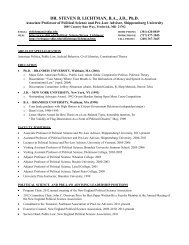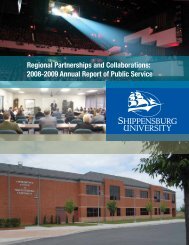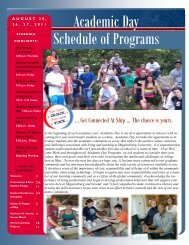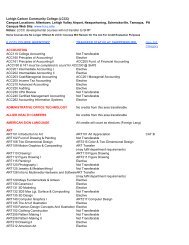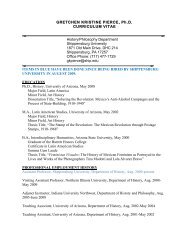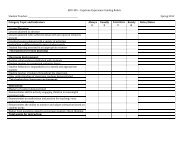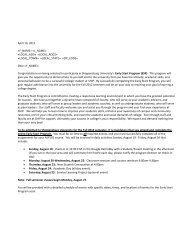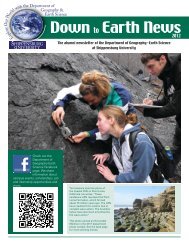Complete Issue - Shippensburg University
Complete Issue - Shippensburg University
Complete Issue - Shippensburg University
- No tags were found...
You also want an ePaper? Increase the reach of your titles
YUMPU automatically turns print PDFs into web optimized ePapers that Google loves.
20 PROTEUS: A Journal of IdeasGeorgia’s experience with statewide water planningmay prove to be instructive for similar initiatives inother states. Georgia’s planning effort has resulted insignificant changes in the state’s approach to watermanagement, changes that may ultimately lead to moreeffective long-term management of the state’s limitedwater resources. This paper outlines significant aspectsof the statewide water planning process, summarizeschanges in management that are now underway, andhighlights characteristics that may contribute to longtermsustainability of resource use and management.Statewide water planning: Bringing users to thetableGeorgia’s Comprehensive Statewide WaterManagement Planning Act was adopted in 2004. 7 Theact established a process for development of a plan ledby the state agencies with major responsibility for watermanagement, followed by consideration and adoptionby the Georgia General Assembly.The act required extensive stakeholder involvementin development of the plan. To meet this statutoryrequirement, a broad-based technical and public inputprocess was conducted from June 2005 to December2007 (Table 1). This process was more extensive andintensive than seen in many statewide water planninginitiatives, and proved to be critical to water planningon a scale not previously attempted in Georgia. Thelinchpin of the process was a series of stakeholderadvisory committees.Advisory committee composition and processThe Comprehensive Statewide Water ManagementPlanning Act established guiding policy for the statewidewater plan: “Georgia manages water resources ina sustainable manner to support the state’s economy, toprotect public health and natural systems, and enhance thequality of life for all citizens” (emphasis added). 8 Thisstatement required a broad planning scope, one thatconsidered a wide range of potentially competing wateruses: 1) offstream or extractive uses, where water iswithdrawn and transported for human consumption,used in industrial processes, or applied for agriculturalproduction, among others; and 2) instream uses thatoccur within the banks of a water body — assimilationof wastewater, recreation, hydrolelectric production, andsupport of fish, wildlife, and other ecosystem services.The breadth of this planning scope requiredequally broad involvement in the advisory committeeprocess. A desire to tap a wide range of interestswas a fundamental premise in defining the advisorycommittees and determining their composition andprocess.Differing geographic interests were involvedthrough seven Basin Advisory Committees (BAC).Six of the seven were organized along river basinboundaries, with each committee’s geographicboundaries encompassing one or more of the state’sfourteen major river basins (Figure 1). A seventhcommittee represented the geographical area of theMetropolitan North Georgia Water Planning District,which was created by state legislation in 2001.BAC members included representatives of localgovernments, business interests, agricultural concerns,environmental advocates, and other non-governmentalorganizations. 9 These committees were convened toprovide structured regional perspectives and input onwater management objectives and potential policytools and/or options. The BAC were not asked toreach consensus on specific issues. The primary goalof the committees was to build a better understandingof divergent opinions and interests in the state’s waterresources. Attempting to reach consensus as a productmay have precluded reaching this goal and, instead,members were simply asked to provide input from adiverse range of perspectives on proposed managementobjectives and policy decisions. The conveningstate agency worked with a wide range of statewideorganizations, from economic developers to canoeingenthusiasts, to identify candidates for each BAC.A Statewide Advisory Committee (SAC) broughttogether representatives of organizations that hadstatewide interests and constituencies, in order toTable 1. Technical and public involvement processComponentAdvisory committeesTown hall meetingsPublic meetings⎯ Technical⎯ Basin⎯ StatewideWeb-based review and comment on draftplansDescriptionFour committees with a total of 45 members and 10 meetingsSeven committees with a total of 187 members and 42 meetingsOne committee with a total of 32 members and 8 meetingThree rounds of meetings held around the state for a total of 22 meetingswith attendance over 2700Two rounds of public meetings/hearings around the state for a total of18 meetings with attendance over 1000Approximately 600 comments through an interactive website and 400comment letters received by mail



